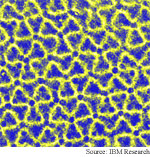|
NEWS
|

|
 |
Nanomaterials
bloom
Much of today's nanotechnology is the result of
materials science research, and materials science, in
turn, is a cross-disciplinary combination of chemistry,
physics and engineering...
|
Nano
gives solar 2-for-1
There are two ways to make solar cells more practical:
decrease their prices and increase their efficiency. The
lion's share of solar cell advances have been in the former
camp -- making solar cells less expensive by making them
from inexpensive materials like like plastics and zinc
oxide. A couple of recent developments, however...
|
Email
shows it's who you know
Social networks are notoriously difficult to study.
Fortunately, computer networks are changing that. Columbia
University researchers studied more than 14 million email
messages generated by more than 43,000 members of a large
university over the course of a year...
|
Sensor
sees spark of life
Increasingly, and in many ways, computer chip
technology is proving invaluable to the life sciences.
Researchers from the University of Manchester in England
and the Institute for Microelectronics Technology in Russia
have made an electric field sensor that detects the electric
charge of a single electron...
|
Bits
and pieces
A microfluidic pressure sensor, an infrared
camera that aligns images on bodies, a prototype interplanetary
laser communications system. |
FEATURES
|
View
from the High Ground: Cornell's Jon Kleinberg
Six degrees of separation, buying gasoline
by the molecule, the science of popularity, all just getting
along online, intellectual prosthetics, Big Science, making
up questions, and telling stories.
|
How
It Works: Quantum computing: qubits
Photons, electrons and atoms, oh my! These particles are
the raw materials for qubits, the basic building blocks
of quantum computers. |
|
 |
News RSS feed 
Blog RSS feed 
Bookshelf RSS feed

New: TRN's
Internet Services
TRN's Jobs Center
|
| |
|
| |
"In
most areas of science and technology, the origins
of new breakthroughs can still be found in the work
of a small number of people -- or even a single
person -- working at their own pace on their own
questions, pursuing things that interest them. "
- Jon Kleinberg, Cornell University |
|
| |
|
| |
Thanks
to Kevin from
GoldBamboo.com
for technical support |
|

